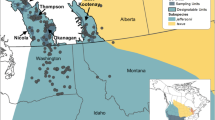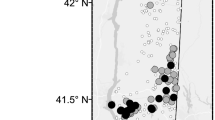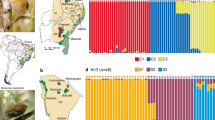Abstract
Northern Goshawks occupying the Alexander Archipelago, Alaska, and coastal British Columbia nest primarily in old-growth and mature forest, which results in spatial heterogeneity in the distribution of individuals across the landscape. We used microsatellite and mitochondrial data to infer genetic structure, gene flow, and fluctuations in population demography through evolutionary time. Patterns in the genetic signatures were used to assess predictions associated with the three population models: panmixia, metapopulation, and isolated populations. Population genetic structure was observed along with asymmetry in gene flow estimates that changed directionality at different temporal scales, consistent with metapopulation model predictions. Therefore, Northern Goshawk assemblages located in the Alexander Archipelago and coastal British Columbia interact through a metapopulation framework, though they may not fit the classic model of a metapopulation. Long-term population sources (coastal mainland British Columbia) and sinks (Revillagigedo and Vancouver islands) were identified. However, there was no trend through evolutionary time in the directionality of dispersal among the remaining assemblages, suggestive of a rescue–effect dynamic. Admiralty, Douglas, and Chichagof island complex appears to be an evolutionarily recent source population in the Alexander Archipelago. In addition, Kupreanof island complex and Kispiox Forest District populations have high dispersal rates to populations in close geographic proximity and potentially serve as local source populations. Metapopulation dynamics occurring in the Alexander Archipelago and coastal British Columbia by Northern Goshawks highlight the importance of both occupied and unoccupied habitats to long-term population persistence of goshawks in this region.



Similar content being viewed by others
References
Avise JC (2004) Molecular markers, natural history, and evolution, 2nd edn. Sinauer Associates Inc., Sunderland
Bandelt HJ, Forster P, Sykes BC, Richards MB (1995) Mitochondrial portraits of human populations. Genetics 141:743–753
BC Ministry of Environment (1995) Biodiversity guidebook. Province of British Columbia, Victoria
BC Ministry of Forests, Mines and Lands (2010) The state of British Columbia’s forests, 3rd edn. Forest Practices and Investment Branch, Victoria. www.for.gov.bc.ca/hfp/sof/index.htm#2010
Beerli P (1998) Estimation of migration rates and population sizes in geographically structured populations. In: Carvalho G (ed) Advances in molecular ecology. NATO–ASI workshop series. IOS Press, Amsterdam, pp 39–53
Beerli P (2002) LAMARC—likelihood analysis with metropolis algorithm using random coalescence. http://evolution.genetics.washington.edu/lamarc.html. Accessed 7 July 2004
Beerli P, Felsenstein J (1999) Maximum likelihood estimation of migration rates and population numbers of two populations using a coalescent approach. Genetics 152:763–773
Beerli P, Felsenstein J (2001) Maximum likelihood estimation of a migration matrix and effective population sizes in n subpopulations by using a coalescent approach. Proc Natl Acad Sci USA 98:4563–4568
Belkhir K, Castric V, Bonhomme F (2002) IDENTIX, a software to test for relatedness in a population using permutation methods. Mol Ecol Notes 2:611–614
Bloxton Jr. TD (2002) Prey abundance, space use, demography, and foraging habitat of Northern Goshawks in Western Washington. MSc Thesis. University of Washington, Seattle
Bohonak AJ (2002) IBD (isolation by distance): a program for analyses of isolation by distance. J Hered 93:153–154
Committee on the Status of Endangered Wildlife in Canada (COSEWIC) (2000) COSEWIC assessment and update status report on the Northern Goshawk laingi subspecies Accipiter gentilis laingi in Canada. Ottawa. www.sararegistry.gc.ca/status/status_e.cfm. Accessed Dec 2007
Cook JA, Dawson NG, MacDonald SO (2006) Conservation of highly fragmented systems: the North temperate Alexander Archipelago. Biol Conserv 133:1–15
Corander J, Waldann P, Marttinen P, Sillanpää MJ (2004) BAPS2: enhanced possibilities for the analysis of genetic population structure. Bioinformatics 20:2363–2369
Cornuet JM, Luikart G (1996) Description and power analysis of two tests for detecting recent population bottlenecks from allele frequency data. Genetics 144:2001–2014
Davies N, Villablanca FX, Roderick GK (1999) Determining the source of individuals: multilocus genotyping in nonequilibrium population genetics. Trends Ecol Evol 14:17–21
Degnan SM, Owens IPF, Clegg SM, Moritz CC, Kikkawa J (1999) MtDNA, microsatellites and coalescence: tracing the colonisation of Silvereyes through the southwest Pacific. In: Adams NJ, Slotow RH (eds) Proceedings of the 22nd International Ornithological Congress, Durban. BirdLife South Africa, Johannesburg, pp 1881–1898
Detrich PJ, Woodbridge B (1994) Territory fidelity, mate fidelity, and movements of color-marked Northern Goshawks in the southern cascades of California. Stud Avian Biol 16:130–132
Di Rienzo A, Peterson AC, Garza JC, Valdes AM, Slaktin M, Freimer NB (1994) Mutational processes of simple-sequence repeat loci in human populations. Proc Natl Acad Sci USA 91:3166–3170
Doyle FI (2005) Breeding Success of the goshawk (A. g. laingi) on Haida Gwaii/Queen Charlotte Islands: is the population continuing to decline? Goshawk productivity and habitat requirements 2004–2005. SMFRA, Weyerhaeuser Ltd., Grande Prairie, pp 1–42
Doyle FI (2006) When do naturally regenerating and pre-commercially thinned second growth forests attain attributes that will support Northern Goshawks (laingi subspecies) and Marbled Murrelets on Haida Gwaii? Cascadia Forest Products Ltd., pp 1–32
Evans DL, Sindelar CR (1974) First record of the goshawk for Louisiana-a collected, banded bird. Bird Banding 45:270
Flatten C, Titus K, Lowell RE (2001) Northern goshawk monitoring, population ecology and diet on the Tongass National Forest. Alaska Department of Fish and Game Research Final Performance Report SE-4-2-6. ADF&G Division of Wildlife Conservation
Fluxus Technology Ltd. (2007) NETWORK 4.5.0.0. Available from www.fluxus-engineering.com. Accessed 10 Feb 2007)
Garza JC, Williamson EG (2001) Detection of reduction in population size using data from microsatellite loci. Mol Ecol 10:305–318
Gautschi B, Tenzer I, Muller JP, Schmid B (2000) Isolation and characterization of microsatellite loci in the bearded vulture (Gypaetus barbatus) and cross-amplification in three Old World vulture species. Mol Ecol 9:2193–2195
Goudet J (1995) FSTAT (vers. 1.2): a computer program to calculate F-statistics. J Hered 86:485–486
Goudet J (2001) FSTAT, version 2.9.3.2. http://www2.unil.ch/izea/softwares/fstat.html. Accessed 7 July 2004
Hancock JM (1999) Microsatellites and other simple sequences: genomic context and mutational mechanisms. In: Goldstein DB, Schlötterer C (eds) Microsatellites: evolution and applications. Oxford University Press, New York, pp 1–9
Handel CM, Pajot LM, Talbot SL, Sage GK (2006) Use of buccal swabs for sampling DNA from nestling and adult birds. Wildl Soc Bull 34:1094–1100
Hanski I, Gaggiotti OE (2004) Ecology, genetics, and evolution of metapopulations. Elsevier Academic Press, Amsterdam
Hanski I, Gilpin M (1997) Metapopulation dynamics: empirical and theoretical investigations. Academic Press, San Diego
Hanski I, Simberloff D (1997) The metapopulation approach, its history, conceptual domain, and application to conservation. In: Hanski I, Gilpin M (eds) Metapopulation biology: ecology, genetics, and evolution. Academic Press, San Diego, pp 5–26
Hansson B, Hasselquist D, Tarka M, Zehtindjiev P, Bensch S (2008) Postglacial colonisation patterns and the role of isolation and expansion in driving diversification in a passerine bird. PLoS One 3:e2794
Hare MP (2001) Prospects for nuclear gene phylogeography. Trends Ecol Evol 16:700–706
Hedrick P (1999) Perspective: highly variable loci and their interpretation in evolution and conservation. Evolution 53:313–318
Howes BJ, Brown JW, Gibbs HL, Herman TB, Mockford SW, Prior KA, Weatherhead PJ (2009) Directional gene flow patterns in disjunct populations of the black ratsnake (Pantheropis obsoletus) and Blanding’s turtle (Emydoidea blandingii). Conserv Genet 10:407–417
Iverson GC, Hayward GD, Titus K, Degayner E, Lowell RE, Crocker-Bedford CD, Schempf FP, Philip F, Lindell J (1996) Conservation assessment of the northern goshawk in southeast Alaska. USDA, Forest Service, Pacific Northwest Research Station PNW-GTR-387
Jensen JL, Bohonak AJ, Kelley ST (2005) Isolation by distance, web service v.3.15. BMC Genetics 6:13. http://ibdws.sdsu.edu/
Kuhner MK, Yamato J, Felsenstein J (1995) Estimating effective population size and neutral mutation rate from sequence data using Metropolis-Hastings sampling. Genetics 140:1421–1430
Levins R (1969) Some demographic and genetic consequences of environmental heterogeneity for biological control. Bull Entomol Soc Am 15:237–240
Levins R (1970) Extinction. In: Gerstenhaber M (ed) Some mathematical problems in biology. American Mathematical Society, Providence, pp 75–107
Lewis SB, Titus K, Fuller MR (2006) Northern goshawk diet during the nesting season in Southeast Alaska. J Wildl Manag 70:1151–1160
Longmire JL, Lewis AK, Brown NC, Buckingham JM, Clark LM, Jones MD, Meincke LJ, Meyne J, Ratliff RL, Ray FA, Wagner RP, Moyzis RK (1988) Isolation and molecular characterization of a highly polymorphic centromeric tandem repeat in the family Falconidae. Genomics 2:14–24
Martinez-Cruz B, David VA, Godoy JA, Negro JJ, O’Brien SJ, Johnson WE (2002) Eighteen polymorphic microsatellite markers for the highly endangered Spanish imperial eagle (Aquila adalberti) and related species. Mol Ecol Notes 2:323–326
Maruyama T, Fuerst PA (1985) Population bottlenecks and non-equilibrium models in population genetics. II. Number of alleles in a small population that was formed by a recent bottleneck. Genetics 111:675–689
Mayer C, Schiegg K, Pasinelli G (2009) Patchy population structure in a short-distance migrant: evidence from genetic and demographic data. Mol Ecol 18:2353–2364
McClaren EL (2005) Northern Goshawk (Accipiter gentilis laingi) population inventory summary for Vancouver Island, British Columbia 1994–2002. Ministry of Environment, Victoria. Wildlife Bulletin No. B-117
Medrano JF, Aasen E, Sharrow L (1990) DNA extraction from nucleated red blood cells. Biotechniques 8:43
Meirmans PG (2006) Using the AMOVA framework to estimate a standardized genetic differentiation measure. Evolution 60:2399–2402
Mira S, Billot C, Guillemaud T, Epplen JT, Palma L, Cancela L (2002) Isolation and characterization of polymorphic microsatellite markers in Eurasian vulture Gyps fulvus. Mol Ecol Notes 2:557–558
Nesje M, Røed KH (2000) Microsatellite DNA markers from the gyrfalcon (Falco rusticolus) and their use in other raptor species. Mol Ecol 9:1438–1440
Northern Goshawk Accipiter gentilis laingi Recovery Team (2008) Recovery strategy for the Northern Goshawk, laingi subspecies (Accipiter gentilis laingi) in British Columbia. Prepared for the B.C. Ministry of Environment, Victoria
Ohta T, Kimura M (1973) A model of mutation appropriate to estimate the number of electrophoretically detectable alleles in a finite population. Genet Res 22:201–204
Orsini L, Corander J, Alasentie A, Hanski I (2008) Genetic spatial structure in a butterfly metapopulation correlates better with past than present demographic structure. Mol Ecol 17:2629–2642
Peck N (2000) DNA forensics of raptors and the isolation and characterization of microsatellite markers in Accipitridae. PhD Dissertation, University of Nottingham, Nottingham
Piry S, Luikart G, Cornuet JM (1999) BOTTLENECK: a computer program for detecting recent reductions in the effective population size using allele frequency data. J Hered 90:502–503
Posada D, Crandall KA (1998) MODELTEST: testing the model of DNA substitution. Bioinformatics 14:817–818
Queller DC, Goodnight KF (1989) Estimating relatedness using genetic markers. Evolution 43:258–275
Raymond M, Rousett F (1995) GENEPOP (version 1.2): population genetics software for exact tests and ecumenicism. J Hered 86:248–249
Reynolds RT, Joy DM (2006) Demography of Northern Goshawks in northern Arizona, 1991–1996. Stud Avian Biol 31:63–74
Rogers AR, Harpending H (1992) Population growth makes waves in the distribution of pairwise genetic differences. Mol Biol Evol 9:552–569
Rousset F (1996) Equilibrium values of measures of population subdivision for stepwise mutation processes. Genetics 142:1357–1362
Schneider S, Roessli D, Excoffier L (2000) ARLEQUIN version 2.0: a software for population genetic data analysis. Genetics and Biometry Laboratory, University of Geneva, Geneva
Slatkin M (1985) Gene flow in natural populations. Annu Rev Ecol Syst 16:393–430
Sonsthagen SA, Talbot SL, White CM (2004) Gene flow and genetic characterization of Northern Goshawks breeding in Utah. Condor 106:826–836
Sonsthagen SA, Rodriguez RL, White CM (2006) Satellite telemetry of Northern Goshawks breeding in Utah: I. Annual movements. Stud Avian Biol 31:239–251
Squires JG, Kennedy PL (2006) Northern Goshawk ecology: an assessment of current knowledge and information needs for conservation and management. Stud Avian Biol 31:8–62
Squires JG, Reynolds RT (1997) Northern Goshawk (Accipiter gentilis) In: Poole A, Gill F (eds) The birds of North America, No 298. The Academy of Natural Sciences, Philadelphia, and the American Ornithologists’ Union, Washington DC
Stacey PB, Johnson VA, Taper ML (1997) Migration within metapopulations: the impact upon local population dynamics. In: Hanski I, Gilpin M (eds) Metapopulation biology: ecology, genetics, and evolution. Academic Press, San Diego, pp 267–291
Talbot SL, Sage GK, Sonsthagen SA, Gust JR, McClaren E, Doyle D, Titus K, Flatten C, Doyle F, Swem T, White CM, Schempf P, Brockman S, Byholm P (submitted) Genetic characterization of Goshawks (Accipiter gentilis) of Alaska and British Columbia: testing subspecies hypotheses. Auk
Valière N (2002) GIMLET: a computer program for analysing genetic individual identification data. Mol Ecol Notes 2:377–379
Waltari E, Cook JA (2005) Historical demographics and phylogeography of arctic hares (Lepus): genetic signatures test glacial refugia hypotheses. Mol Ecol 14:3005–3016
Wang IJ (2010) Recognizing the temporal distinctions between landscape genetics and phylogeography. Mol Ecol 19:2605–2608
Waples RS (2006) A bias correction for estimates of effective population size based on linkage disequilibrium at unlinked gene loci. Conserv Genet 7:167–184
Waples RS, Do C (2008) L d N e: a program for estimating effective population size from data on linkage disequilibrium. Mol Ecol Resour 8:754–756
Wiens JD, Reynolds RT, Noon BR (2006) Juvenile movement and natal dispersal of northern goshawks in Arizona. Condor 108:253–269
Wilson GA, Rannala B (2003) Bayesian inference of recent migration rates using multilocus genotypes. Genetics 163:1177–1191
Acknowledgments
This paper would not have been possible without the help from many individuals who provided field, logistic, and laboratory assistance. Funding was provided by Brigham Young University, US Geological Survey Alaska Science Center, US Forest Service, Environment Canada, and the US Fish and Wildlife Service. Technological support was provided by Shawn Houston, University of Alaska Life Science Informatics computer cluster (NIH P20RR016466). We especially thank the Bird Treatment and Learning Center in Anchorage, Alaska, for providing samples useful in marker development. CR Dial, J Rearick, and J Unland rendered laboratory assistance. The manuscript was improved by comments from P Beerli, Florida State University; S Boyce, US Forest Service; V Penteriani, Estación Biológica de Doñana, C.S.I.C.; and two anonymous reviewers. Mention of trade names or commercial products does not constitute endorsement or recommendation for use.
Author information
Authors and Affiliations
Corresponding author
Electronic supplementary material
Below is the link to the electronic supplementary material.
Rights and permissions
About this article
Cite this article
Sonsthagen, S.A., McClaren, E.L., Doyle, F.I. et al. Identification of metapopulation dynamics among Northern Goshawks of the Alexander Archipelago, Alaska, and Coastal British Columbia. Conserv Genet 13, 1045–1057 (2012). https://doi.org/10.1007/s10592-012-0352-z
Received:
Accepted:
Published:
Issue Date:
DOI: https://doi.org/10.1007/s10592-012-0352-z




